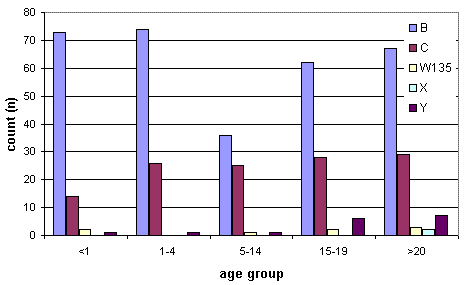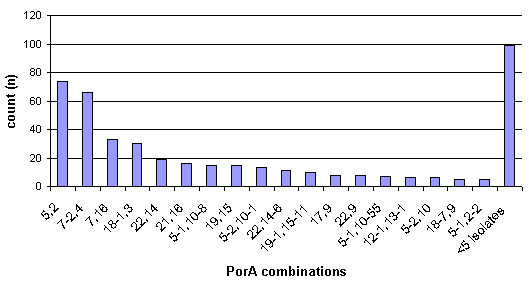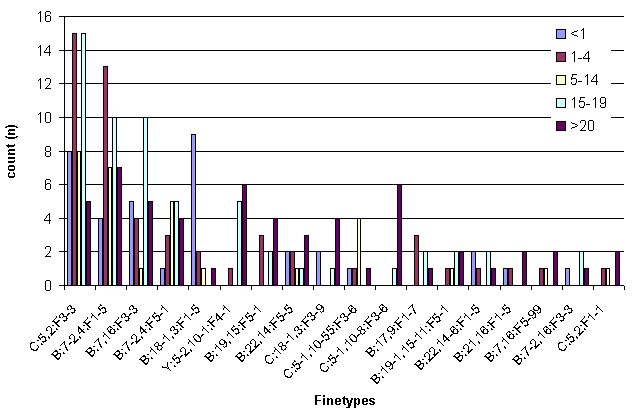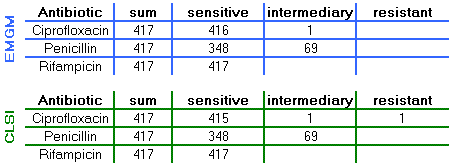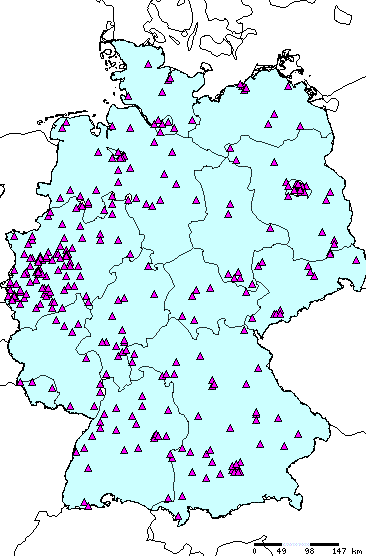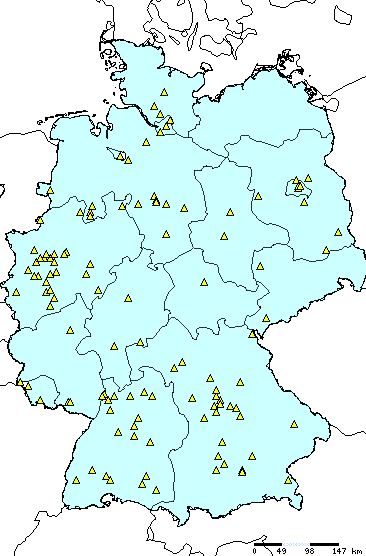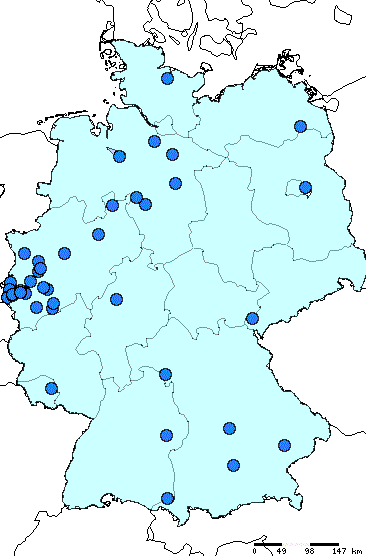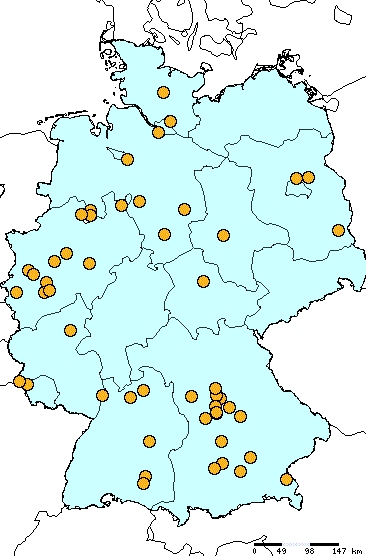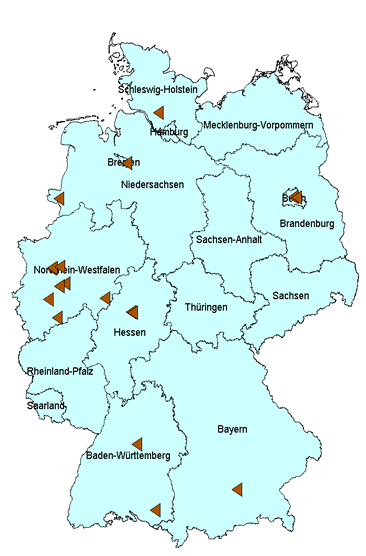Data 2006 (eng)
Data of the German Reference Centre for Meningococci 2006
1) Introduction
The German Reference Centre for Meningococci (NRZM) is assigned by the Robert-Koch-Institute (RKI) to perform finetyping on meningococcal strains and to survey trends in antibiotic susceptibilities. In the year 2006 it processed 673 samples from 609 patients. Neisseria meningitidis was identified in 541 individuals. In 461 cases the organism was detected in normally sterile body fluids (e.g. csf). During the same period 526 cases of invasive meningococcal disease (IMD) were reported to the RKI (data as of 3.1.2007, cf. SurvStat@RKI). For 67 patients the detection of meningococci was carried out solely with non-culture methods. The share of serogroup C disease slightly rose to 26,5%, whilst that of serogroup B disease decreased to 67,8%. Meningococci of the serogroups Y and W-135 caused 3,5% and 1,7% of all invasive diseases, respectively.
Apart from the serogroup, PorA and FetA are important targets for finetyping (see our previous reports for 2004 and 2005). 180 unique serogroup-PorA-FetA combinations were observed in 2006 (each of these unique combinations represents a "finetype"). The previously most common finetype B:P1.7-2,4:F1-5 was superseded by C:P1.5,2:F3-3. The most common finetypes for the year 2006 were C:P1.5,2:F3-3 (11,5% of all invasive isolates), B:P1.7-2,4:F1-5 (9,2%), B:P1.7,16:F3-3 (5,6%), B:P1.7-2,4:F5-1 (4,1%), and B:P1.18-1,3:F1-5 (2,9%) (see below).
Early detection of finetype-specific clusters and the interpretation of spatial dynamics of disease are greatly facilitated since the implementation of the geographical information system EpiScanGIS in summer 2006. The website was created in cooperation with the 2nd Chair of Computer Science (University of Wuerzburg) and Ridom. Among other software it incorporates the freely available and thorouhly evaluated program SaTScan for the identification of spatio-temporal clusters.
2) Serogroup distribution according to German states

6) Antibiotic susceptibilities 2006:
7) Geographical distribution of cases 2006
Remarks: Spatial distribution of serogroups B and C is comparable. As in the previous years the finetype B:P1.7-2,4:F1-5 accumulates in western NRW. Moreover C:P1.5,2:F3-3 clusters in the area of Middle Franconia, particularly apparent in the 2nd quarter of 2006. As before, ET-15 meningococci were particularly prevalent in NRW. In contrast, occurrence of this clone in BW and BY decreased. Nevertheless, the numbers of ET-15 cases in Germany are likely underestimated, since only culture confirmed cases are included.
The asterisk (*) denotes maps, that have been generated using EpiScanGIS.
8) Reported lethality for serogroups B and C 2006
9) Publications of the NRZM 2006
Research articles:
- Elias J, Harmsen D, Claus H, Hellenbrand W, Frosch M, Vogel U. Spatio-temporal Analysis of Invasive Meningococcal Disease, Germany. Emerg Infect Dis 2006;12:1689-1694.
- Elias J, Wartburgkreis Gesundheitsamt, Claus H, Frosch M, Vogel U. Evidence for indirect nosocomial transmission of Neisseria meningitidis resulting in two cases of invasive meningococcal disease. J Clin Microbiol 2006;44:4276-4278.
- Schrauder A, Claus H, Elias J, Vogel U, Haas W, Hellenbrand W. Capture-recapture analysis to estimate the incidence of invasive meningococcal disease in Germany, 2003. Epidemiol Infect 2006:1-8.
- Oppermann, H., B. Thriene, H.M. Irmscher, L. Grafe, M. Borrmann, D. Bellstedt, S. Kaynak, W. Hellenbrand & U. Vogel. 2006. [Meningococcal carriage in high school students and possible risk factors]. Gesundheitswesen 68, 633-7.
- Elias, J. and U. Vogel. 2007. IS1301 Fingerprint Analysis of Neisseria meningitidis Strains Belonging to the ET-15 Clone. J. Clin. Microbiol. 45:159-167.
- Findlow, H., Vogel, U., Mueller, J.E., Curry, A., Njanpop-Lafourcade, B.M., Claus, H., Gray, S.J., Yaro, S., Traoré, Y., Sangaré, L., Nicolas, P., Gessner, B.D., and Borrow, R. Three cases of invasive meningococcal disease in Burkina Faso caused by a capsule null locus strain circulating among healthy carriers. J. Infect. Dis. accepted for publication.
Review articles and books:
- Schröter M, Elias J, Hellenbrand W, Ziemer B, Baumeister H, Vogel U. Die Epidemiologie von Neisseria meningitidis in NRW. Rheinisches Ärzteblatt 2006;4:19-21.
- Elias J, Reinhardt M, Frosch M, Vogel U. Meningokokkeninfektionen in Deutschland 2005: Daten des Nationalen Referenzzentrums. 6 ImpfDialog (3) 119-124 (2006)
- Claus, H., Vogel, U., Swiderek, S., Frosch, M., and Schoen, S. 2006. Microarray analyses of meningococcal genome composition and gene regulation: review of the recent literature. In revision FEMS Microbiol. Rev. Epub ahead of print.
- Fox, A.J., Taha, M.K., and Vogel, U. Standardized non-culture techniques recommended for European reference laboratories. FEMS Microbiol. Rev. Epub ahead of print.
General information: The data are generated and collected by the NRZM on behalf of the RKI. All rights reserved.
English Version 1.1, updated 9.4.2008, © NRZM 2007

